US metro systems in cities such as Washington DC, Chicago, San Francisco, and Los Angeles share an interesting design feature. All of these systems have major segments where different routes share the same track. For example, Washington DC’s metro has three individual lines that share tracks from Rosslyn station to Stadium-Armory station. Meanwhile, Chicago’s rail system can have up to five different lines (including one special rush-hour service) share the same tracks along the city’s iconic elevated “loop”.
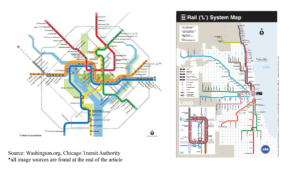
This phenomenon where multiple train routes share the same tracks is called interlining and can be found in metros all around the world. However, most metro systems in other countries only interline some of their routes. US metros, on the other hand, interline nearly all of their routes. Furthermore, these interlined routes take center-stage in these metros, passing through their respective urban centers before fanning out into the surrounding suburbs.
The main advantage of this design is that it allows commuters to directly travel in and out of a city’s downtown area without having to transfer between trains, something known as a one-seat ride. For example, in San Francisco’s BART, every single station (with the exception of its eBART light rail extension) is serviced by a route that goes directly to San Francisco. In other words, BART provides every heavy rail station with a one-seat ride to San Francisco.
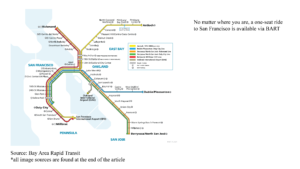
So while metros oriented around “one-seat rides” have the advantage of streamlining trips in and out of a specific location, they also come with some significant drawbacks. The first drawback of this design is its impact on the maximum frequency of service each line is capable of providing. Because multiple routes in a system are forced to share the same track, a bottleneck is created that limits the maximum frequency of each individual route to the maximum capacity of the shared section divided by the number of lines sharing that section.
For example, take a look at this diagram of a hypothetical metro system. It has four routes, all of which interline through a central corridor that has a maximum capacity of 24 trains per hour in each direction. Therefore, when this system is running at maximum capacity, any given station along the central corridor can serve up to 24 trains per hour in each direction (or one train every 2.5 minutes). However, as this central corridor serves four different routes, each route (and therefore any station outside the central corridor) can only serve up to 6 trains per hour in each direction (or only one train every 10 minutes). This decrease in frequency decreases system capacity, disincentivizes ridership, and limits the system’s ability to serve trips that do not involve going in and out of one specific location. This last consequence brings us to the second disadvantage of a system that follows this interlined model.
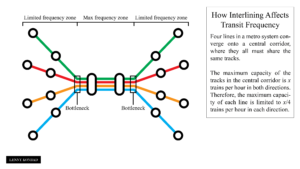
While a metro under this design may make trips in and out of one specific location more comfortable, its lowered frequencies make trips that require transferring between trains much longer. To explain this disadvantage, let us use a real system: BART. If you were, for example, to travel from Downtown Berkeley station to Lafayette station (a map of BART is provided below for reference), you will have to first take either the red or orange lines before transferring to the yellow line through either MacArthur, 19th Street/Oakland, or 12th Street/Oakland City Center. Since timed transfers are not available for southbound to northbound trains (only for northbound to northbound or southbound to southbound between the orange and yellow lines), you can wait up to 10 minutes to complete your transfer given BART is running at its full capacity of 24 trains per through its interlined corridor (1). However, if you decide to that this journey during BART’s off-peak hours, you can find yourself waiting up to 30 minutes to complete your transfer (2).
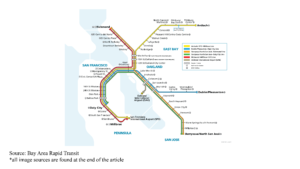
This interlined hub-and-spoke design assumed by many US metros has prompted some to even argue that it would be inaccurate to classify these transit systems as “true” metros. Rather, their design makes them more reminiscent of a German S Bahn, a hybrid between urban metros and suburban commuter rail that use the same interlined hub-and-spoke model. Like a commuter rail, it connects urban cores to their surrounding suburbs and peripheral satellite towns through a network of low-frequency routes. As these routes approach the urban core, they converge to form high-frequency interlined corridors that behave more like a metro.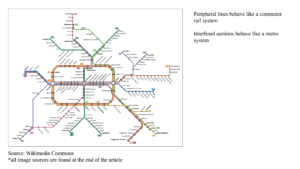
The success of Germany’s S Bahn systems poses the question: do the drawbacks of an interlined hub-and-spoke metro system outweigh its benefits? It is possible that since suburbs are so sparsely populated, the lowered frequencies of the routes that pass through them due to interlining is not a significant drawback. After all, suburbs simply lack the population density needed to justify high-frequency train service. Furthermore, are there really enough people who want to commute from suburb to suburb to justify the removal of one-seat rides in and out of downtown areas?
However, if American transit in the 21st century wishes to be truly competitive with the automobile, American transit’s primary competitor, addressing the disadvantages of an interlined hub-and-spoke metro system is absolutely paramount. To many Americans, the automobile is more liberating than public transportation as it provides them with the ability to go wherever they want whenever they want. Transit in its current state can be seen as antithetical to these freedoms; low frequencies make it reliant on schedules and its focus on one-seat rides limits choice in destination. However, if transit is designed around high frequencies and general mobility, it can function as a series of conveyor belts that can transport people wherever they want whenever they want without the cost and liabilities of car ownership.
Transit focused on general mobility rather than downtown commutes can even make more sense economically. Nowadays, more Americans are commuting between suburbs instead of between suburbs and urban centers (3). This means that while current transit can only compete with other modes of transportation when it comes to downtown commutes, transit focused on general mobility can compete for commuters that go in every direction, broadening its share of the market.
To understand how this can be achieved through design, let us take a look at Hong Kong’s MTR system. While imperfect, it is often regarded as among the world’s best metro systems. The first thing to notice about this system is the near absence of interlining, with the exception of parts of the Tung Chung line (orange) and Airport Express (cyan) (however, the specialized nature of the Airport Express means that it runs at such a low frequency that it has a negligible impact on the frequency of the Tung Chung line) along with the East Rail Line, which shares tracks with some other trains outside of the MTR system.
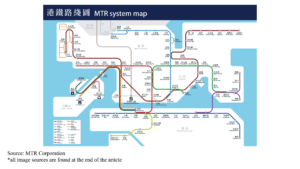
You may notice a few other sections of the MTR that appear to be interlined. However, this is not the case because individual lines do not have to share any infrastructure. Instead, each line is offered its own dedicated track and boarding platforms. For example, if you look at this diagram of Mong Kok station (as shown below), you can see four boarding platforms, two for each line that passes through the station (red and green). This ensures that each line can operate trains as frequently as possible.
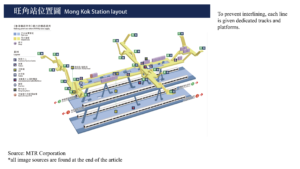
The reason why lines in the MTR occasionally run parallel to one another is to allow passengers to change trains through a system called cross-platform interchanges. This system allows passengers to change trains at a designated station by simply crossing a platform, minimizing the time and energy it takes to transfer between lines, improving both efficiency and passenger experience.
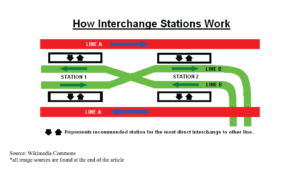
Therefore, while US metros were designed around one-seat rides at the expense of frequency and flexibility, Hong Kong’s MTR was designed around frequency and flexibility at the expense of one-seat rides.
So what would US metros look like if they were redesigned with the principles that define Hong Kong’s MTR? As a proof of concept, I created a hypothetical redesign of San Francisco’s BART that would optimize frequency and transfers while requiring as little additional infrastructure as possible. The following system map is the result.
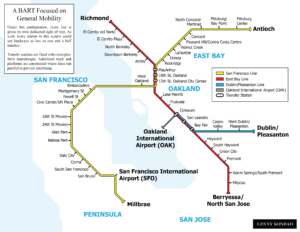
Similar to Hong Kong’s MTR, interlining is absent. This means that the entire system is able to run at maximum capacity. Stations that once saw minimum frequencies of one train every 15 minutes can now see frequencies as low as one train every two and a half minutes. This means that even if the system is running at only 50% of its max capacity, frequencies can still be as low as 5 minutes. While the current BART system is one designed for San Francisco commuters, this system is designed for anyone to go anywhere where there is coverage.
Of course, this system is a lot more than just BART with redrawn routes. Some additional infrastructure will be needed to prevent interlining along this system’s two parallel corridors. The corridor from MacArthur to 12th St. Oakland City Center, where the red and yellow lines run parallel, will require an additional track to convert it from a triple tracked section to a quadruple tracked section. Furthermore, both 19th St. Oakland and 12th St. Oakland City Center will need one extra platform each, strategically placed to create a cross-platform interchange.
The corridor from Bay Fair to Coliseum, where the red and blue lines run parallel, will require two additional tracks to convert it from a double-tracked section to a quadruple tracked section. Furthermore, all three stations in this corridor—Bay Fair, San Leandro, and Coliseum—will all need two extra platforms each, strategically placed to create a cross-platform interchange. Since this corridor is elevated rather than underground, adding these additional platforms may require additional care and precision.
Finally, depending on the current limits of the current BART fleet, additional rolling stock may be needed to maintain high frequencies.
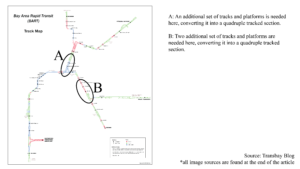
Aside from the reduction of possible one-seat rides in and out of San Francisco, this system has a few other disadvantages. By removing the system bottlenecks that are a consequence of interlining, this system may create bottlenecks in transfer stations as large numbers of passengers change trains to complete their commute. Even at maximum frequency, individual trains may reach their full capacity before everyone in a station can board it. As such, someone transferring trains during peak hours may have to wait for multiple trains to pass by before they can finally board one. This problem can also take place in stations downstream from other busy stations. For example, commuters leaving San Francisco from Embarcadero station during peak hours may see multiple trains pass by at full capacity.
Another issue also stems from this drawback: station capacity. Some may argue that, even with the added infrastructure, existing BART station platforms are simply not wide enough to accommodate all of the transferring passengers. Admiralty station, one of the Hong Kong MTR’s busiest transfer stations, features incredibly wide platforms to accommodate the transferring passengers. Despite this, the capacity of this platform is still pushed to its limits during peak hours.
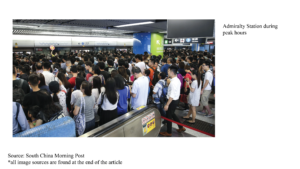
To those in support of hub-and-spoke interlining, this issue highlights why transit systems should be optimized in favor of popular routes instead of general mobility. By designing a system to be a jack of all trades, new problems are bound to emerge, even if additional crowd control measures are introduced. To the advocates of a deinterlined system, however, its benefits outweigh the drawbacks. Regardless, if the US wishes to keep its transit systems competitive with other modes of transportation, it may be worthwhile to indulge in the possibilities, even the ones that may seem radical.
Further Reading:
The following articles and web pages further touch on the subject of transfers and interlining in US public transit.
- An article by the transit consultant and online blogger Jarrett Walker about the benefits of creating transit focused on transfers
https://humantransit.org/2009/04/why-transferring-is-good-for-you-and-good-for-your-city.html - Another article by Jarrett Walker about the interlining of San Francisco’s MUNI Metro light rail system
https://humantransit.org/2020/06/san-francisco-a-forbidden-fantasy-comes-true.html - A proposal to completely remove interlining from San Francisco’s MUNI Metro light rail system
http://newmunimetro.com/m-market/ - An article from the blog Pedestrian Observations, which proposes a redesigned New York Subway that eliminates a form of interlining called reverse branching.
https://pedestrianobservations.com/2018/06/12/how-deinterlining-can-improve-new-york-city-transit/
Sources:
- https://www.bart.gov/about/projects/corecapacity
- https://www.bart.gov/schedules
- https://www.washingtonpost.com/outlook/five-myths/five-myths-about-the-suburbs/2020/10/02/b5a060fe-0404-11eb-897d-3a6201d6643f_story.html
Image sources:
- https://washington.org/navigating-dc-metro
- https://www.transitchicago.com/maps/
- https://www.bart.gov/schedules
- https://commons.wikimedia.org/wiki/File:S-Bahn_Berlin_-_Netzplan.svg
- https://www.mtr.com.hk/en/customer/services/system_map.html
- https://www.mtr.com.hk/archive/ch/services/layouts/mok.pdf
- https://transbayblog.com/2008/07/23/new-feature-bart-track-map/
- https://www.bart.gov/about/projects/corecapacity#:~:text=The%20Transbay%20Corridor%20Core%20Capacity,used%20part%20of%20its%20system.
- https://www.scmp.com/comment/letters/article/2162698/what-daily-rush-hour-queues-mtr-admiralty-station-reveal

Thank you for this super informative article! The explanations are easy to follow, and the original images look great!